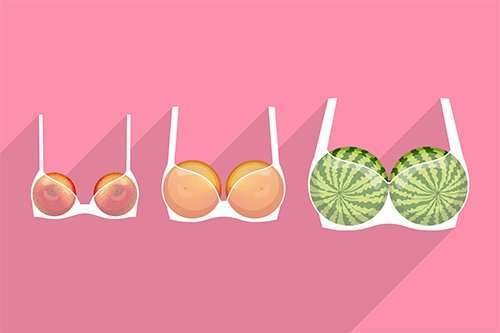CC Breast Implant Sizing – What does it mean for your bra size?
How do you decide which breast implant size is best for your body and lifestyle? Consider proportion and projection.
Breast implant size (volume measured in cc or cubic centimeters) and profile (the projection or “height”) is one of the key decisions in augmentation mammoplasty to achieve a natural and proportionate result. Achieving this balance is a daunting task, but you will not do it alone.
What are the drawbacks of “too small” implants?
- If you get implants that seem too small for your body, you will undoubtedly be tempted to go back to the operating table and ask for “bigger” prostheses.
- This usually occurs after the initial swelling of the tissues from surgery.
- But with any plastic surgery operation, you will have to wait at least 6 – and ideally 12 months – for everything to heal properly.
- And secondary surgeries are more likely to have more pronounced scarring, or damage to delicate tissues from multiple surgeries; this is best avoided if possible.
How to avoid this problem with your breast implants?
- Use computerized 3D technology to visualize the appearance of the implants in your body.
- Recognize that this is only a “sample” and is not predictive – humans, in real life after surgery, and machines, in visual results, will always have differences – some may be significant BUT these technologies (such as the Vectra models) are very useful for visualization from an outside perspective
- Wear the fillers for a few days in different sizes, in many different sets, and ask yourself:
Which ones feel most comfortable when I do my daily activities (yoga, walking, biking, stretching, working on the computer, etc.)
Which ones look best in terms of proportion and projection? - It should be noted that the position of the nipple-areola complex and the distance between the nipples, as well as the location of the center of the breast mound in the rib cage, influence how the implants will look once placed.
For example, where they will be placed when surgically placed under the existing tissues, or partially under the muscle. - The appearance of the upper pole (in terms of cleavage) once the implants are in place.
While there is no right answer – only you can decide – a good surgeon will help you make that decision by using a variety of methods to help you visualize – and experience – how each size of CC implant will end up “looking” on your overall physique.
What are the drawbacks of “too large” implants?
- If you get implants that you or others consider too large for your body, you will end up looking unnatural and disproportionate.
- Your balance may be affected and fitness activities may be less comfortable, especially those that require you to stretch forward (such as yoga or cycling).
- You will need a much firmer support bra.
- You’ll also need new workout gear to fit your upper body, and you may end up looking heavier than you really are, simply because of the bulk.
- More importantly, heavy prostheses can damage breast tissue over time.
- The heavier the implant, the faster the breasts will sag (or sag) over time.
- In addition, when the time comes to replace them or remove them completely (in case more natural tissue develops, for example, as you gain weight with age), the skin is more likely to need a lift than if you had smaller implants.
- However, it is difficult to know the impact in this particular case, as any size implant has to stretch the skin to some extent; and it depends on how old you are when you undergo secondary replacement or removal surgery).
- Remember that no implant lasts forever: the average recommended time for breast implants is to replace the prosthesis every 10 years.
How to avoid this problem with your breast implants:
- Sometimes, “cleavage” envy takes over when we make decisions about augmentation surgery.
- So choosing a surgeon who brings “balance” and “proportion” to the breast implant surgery equation is paramount to a successful operation.
- 3D computerized technology is an excellent way to visualize how the implants might look on your physique; but for larger implants, it is imperative that you also use the fillers – and feel what that extra weight is like to carry on your upper torso.
- Again, recognizing 3D technology such as VECTRA is only a “sample” and is not predictive.
Summary
-
- If you want to avoid the costs of going back across the operating table the following year to get a larger CC prosthesis because you thought it was “too small” with your original decision;
- If you want your prosthesis to look great for years to come;
- If you want to look natural and feel comfortable with your physique during all your typical activities, including exercise and the gym;
- And if you don’t want a “cartoon” look where everyone comments on your breast size and forgets to look you in the eye, it’s important to go for the right size prosthesis.
Bra cup size and CC implant size (Breast Implant CC Choices)

How many cubic centimeters of an implant equals one more bra size?
Asking how many cubic centimeters are in a bra size is a question fraught with problems. The bottom line is that there is no consistent answer. So if you are considering what size breast implant (in terms of CC volume and projection) is best for YOUR physique, then consider the above
There is no real means to provide a consistent answer. The fact is that every person is different, and every body is different. What a given implant size will do to your physique can vary, based on numerous factors.
Factors that impact your appearance before and after augmentation include:
- Skin envelope and dermal tissue strength
- Existing breast tissue composition (muscle vs. fat)
- Areola location, nipple size and nipple spacing
- Surgical placement decisions – under or over the muscle.
- Insertion options – inframammary fold or axillary incisions
- Differences in existing breast tissues (anatomical variations between left and right size, sometimes as extreme as 20% – which could mean you need a larger size on one side than the other).
General overview of the CCs in breast implant sizing options and determining which one is best for you.
CC’s stands for cubic centimeters of volume – this is NOT a “bra cup” or cup size measurement.
- Volume CCs are a standard and accurate measurement, there are no variations.
- Compare this with brasier cup sizes, which have huge variations between brands.
Are bra cup sizes consistent between brands, or do they vary?
- Bra brands usually follow their own sizing charts.
- They are generally similar, but not identical, and the differences can be extreme, which is what you will find when you shop for bras online rather than going in person and having a bra consultant help you make decisions that are truly right for your body and your particular cup size.
- For example: a B or C cup in one brand of bra may be a C or D cup – even an F cup – in another brand.
- Not to mention that the style of a bra alters the way it holds our breast tissue (even after augmentation surgery), and settles into our physique.
Think about it. Your cleavage is likely to look very different in a soft, sculpted t-shirt bra than it does in an underwire push-up bra or sports bra or other type of garment. And just a reminder: after augmentation surgery, no underwire bras are allowed for at least 12 months (or longer).Why? It can interfere with healing and scarring.
Proportion and projection: DC sizes of breast implants and their relation to bra cup sizes

Patients often say “I want to be a C cup” or “I want to go from a B cup to a D cup”.
If only it were as simple as that. However, it is not, as we have described above.
A good surgeon will take multiple things into account when helping you make the right decision.
Always choose a specialized plastic surgeon
They must also have extensive surgical experience and an area of focus in breast augmentation for ALL ages and body types; and/or breast lift with augmentation, after pregnancy or aging.
The best decision when it comes to augmentation surgery is a collaborative effort. Both you and your Plastic Surgeon Specialist make an informed surgical decision together, in terms of implant size and how it will look on your overall physique. But ultimately, a good Plastic Surgeon will have technologies to help you decide; and will offer recommendations based on their experience.
Physical aspects influencing the choice of augmentation (CC) implant size and final bra cup size
- Are your breasts, in general, positioned high or low on your torso and rib cage (compared to the shoulder and navel line)?
- Do your breasts currently have any natural cleavage or are they generally more on the non-projected side?
- Do your breasts tend to point outward (or are they positioned “east” or “west,” i.e., do they naturally point to one side or more to the front)?
- Do the nipples face forward, to the side, up or down? Are they similar in shape, size and direction?
- Is your torso quite small or is your build more athletic and solid, or do you fall somewhere in between?
- Is your rib cage convex or concave?
Summary on the choice of the best breast implant size
Many and varied aspects of your physique are considered in the equation of choosing implant size. By taking these into account, as well as your lifestyle, you can make a decision you will be happy with for years to come.
They may be slightly smaller or larger than you expected; if so, let them sit for some time before you consider removing or replacing them. Also, 10 years from now, your lifestyle may change and when it comes time to replace them again, you may decide whether they are larger or smaller (depending on the strength of your tissues, of course, which DOES change with age, over time and if you forget to wear that support bra as instructed).



